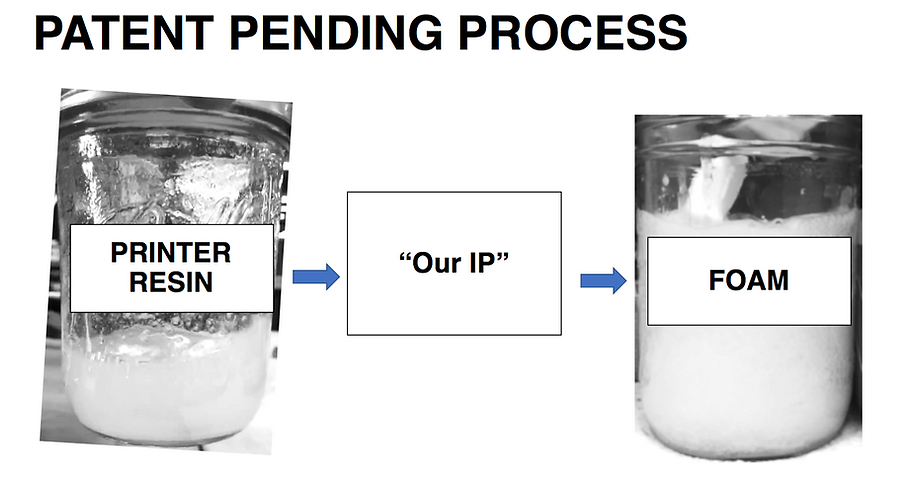PrintFoam has launched a large-format foam 3D printer, which uses resins to produce foam parts. Rather than use a vat printing process, the startup leverages a novel optical patterning technique. According to PrintFoam founder Matthew Pearlson, the technology makes it “possible to produce plywood sized sheets of 3D printed foam in a matter of minutes.”
Spun out of MIT in 2016, the company has an interesting new field open to it. The technology works by creating gas bubbles in a liquid photopolymer resin that then lead to closed-cell foam parts. In 2018, we looked at the genesis of the project and the implications.
“It really is remarkable, and I haven’t seen anything like it. Everyone in the field is attempting to mimic the behavior of traditional foams using plastic lattices produced by computational models. These models keep telling engineers to generate lattices with smaller struts and smaller unit-cells… In essence, the computer is screaming at the engineer to stop what they’re doing and use a foam for the application. As a community, we haven’t been listening and acting on this,” noted Dr. David Walker, Co-Founder of Azul 3D and chair of the Photopolymer Additive Manufacturing Alliance Executive Advisory Board.

Light-weighting is something we think for such applications as aerospace, but in our previous articles, we learned that Pearlson’s vision is much broader than this. With the technology currently in beta, PrintFoam is initially targeting wall panels for use in construction and the interiors of homes and offices.

“Longer-term, I would love to print very large-scale things, like garbage trucks. I like envisioning a world where a garbage truck rolls down the street and you don’t even know it’s there: it’s lightweight, electric, quiet. Garbage trucks get like three miles to the gallon,” Pearlson said. “They’re expensive to maintain, and almost as heavy when empty as when they’re full of garbage. They not only have poor gas mileage, they also wear down their brakes quickly, and those are expensive to repair and replace. Electrify these vehicles and there’s a much lower cost of ownership. It’s a better urban or suburban lifestyle because you don’t have this big heavy equipment. The same goes for buses.¨
Taken in that context this could be a very interesting development indeed. I’m very bullish on 3D printed foam. I think that, if we can design foams that work well, we could take over a lot of applications from sporting goods to braces and automotive seating. But, I’ve never really thought about it as something that has very large-scale applications. Architectural elements such as room dividers could very well be a niche for this kind of technology.
However, if we look at automotive or large vehicle body panels, then the sky is really the limit. It’s traditionally just the kind of thing that would never ever make sense for 3D printing. Then again, maybe with PrintFoam we could be seeing a larger application area in just the kind of large flat panel surfaces that have traditionally been the purview of other technologies.
I’m a huge fan of digital foam, and we’ve written about a lot of applications for foam from construction concrete, or its use as an insulator, foam for NASA, foaming lightweight PLA and more. In all of these cases foam is a lightweight solution that provides a durable, strong or tough part that may even be flexible or soft as per your requirements. In our 3DPOD episode with Elissa Ross, we learned that you can design part- or application-specific foams based on specific requirements. Foams are an area with a lot of potential impact from helmets to seats and construction.
Subscribe to Our Email Newsletter
Stay up-to-date on all the latest news from the 3D printing industry and receive information and offers from third party vendors.
You May Also Like
NSF Awards Kentucky $1M for Advanced Manufacturing
The National Science Foundation has awarded a $1 million grant to the University of Louisville for the Advancing Manufacturing and Building Construction Technologies (NSF AMT) project. This initiative is part...
3D Printing News Briefs, May 11, 2024: 3D Printed Stent, Tower, Sculptures, & More
We’re starting off with medical research in today’s 3D Printing News Briefs, as researchers in Korea used CT images and 3D printing to fabricate an educational simulator for a mastoidectomy....
3D Printing Unpeeled: Wind Turbines, Probiotics and Lenses
TPI Composites, ORNL and Ingersoll Rand are working to make wind turbine tooling segments that can be 18.3 meters long. These elements also include resistive wires that help keep the...
Tethon 3D Releases Cost-effective Bioprinter
Tethon 3D, known for its ceramic-loaded DLP materials, custom resins, and DLP 3D printers, has recently released a bioprinter. Vat polymerization printers like DLP systems have been widely used by...
































